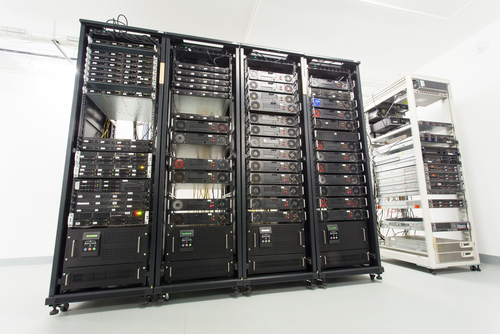 EMC has unveiled a new line of hardware and software designed to protect internal data, as well as beat back some of the data fragmentation that companies naturally accumulate over months or years of operations. EMC’s Protection Storage Architecture features ultra-durable Protection Storage (which includes disaster recovery, backup and archive elements); Data Source Integration that makes various data-streams more visible to the end user; and Data Management Services, which EMC describes as “a catalog of all data copies plus reporting and analytics for compliance.” The new technologies enhancing that Protection Storage Architecture include a faster set of midrange data-domain systems, which consolidate backup and archive data onto a single protection-storage platform; extended backup and archive application support, including Oracle Exadata and SAP HANA Studio via NFS; and data-protection suite enhancements that can protect all major datacenter workloads under the umbrella of EMC Avamar 7. EMC is throwing around the term “accidental architecture” to describe the fragmentation that develops within companies as they integrate successive data-storage and archiving systems into their networks. “Accidental architectures are an outgrowth of users addressing individual data protection challenges reactively as they arise, and applying costly silo'd or ‘one size fits all' products and solutions that become difficult to manage, optimize and pay for,” Guy Churchward, president of EMC’s Backup Recovery Systems Division, wrote in a statement. IT vendors, of course, often try to persuade potential clients to avoid that sort of fragmentation by buying all their technology only from them. But as evidenced by the recent string of partnership agreements among technology’s biggest (and most competitive) players, that model is starting to collapse. In its place, those companies are building software that can interoperate with rival products. In June, for example, Oracle—a company known for engaging in cutthroat competition—pledged to support rival Salesforce offerings in the Oracle Fusion HCM and Financial Cloud. And a variety of firms, including IBM and Hewlett-Packard, are standardizing their cloud products on the open-source OpenStack Infrastructure-as-a-Service (IaaS) platform—the better to interoperate with one another, and thus build a united front of sorts against Amazon, the King Kong of the IaaS space. That general slide toward interoperability and partnerships could lead to all sorts of silo’ing and fragmentation, as companies embrace multiple products for their storage and analytics needs. EMC is evidently trying to get ahead of a market for products that clean up some of that mess. Image: Stefan Petru Andronache/Shutterstock.com
EMC has unveiled a new line of hardware and software designed to protect internal data, as well as beat back some of the data fragmentation that companies naturally accumulate over months or years of operations. EMC’s Protection Storage Architecture features ultra-durable Protection Storage (which includes disaster recovery, backup and archive elements); Data Source Integration that makes various data-streams more visible to the end user; and Data Management Services, which EMC describes as “a catalog of all data copies plus reporting and analytics for compliance.” The new technologies enhancing that Protection Storage Architecture include a faster set of midrange data-domain systems, which consolidate backup and archive data onto a single protection-storage platform; extended backup and archive application support, including Oracle Exadata and SAP HANA Studio via NFS; and data-protection suite enhancements that can protect all major datacenter workloads under the umbrella of EMC Avamar 7. EMC is throwing around the term “accidental architecture” to describe the fragmentation that develops within companies as they integrate successive data-storage and archiving systems into their networks. “Accidental architectures are an outgrowth of users addressing individual data protection challenges reactively as they arise, and applying costly silo'd or ‘one size fits all' products and solutions that become difficult to manage, optimize and pay for,” Guy Churchward, president of EMC’s Backup Recovery Systems Division, wrote in a statement. IT vendors, of course, often try to persuade potential clients to avoid that sort of fragmentation by buying all their technology only from them. But as evidenced by the recent string of partnership agreements among technology’s biggest (and most competitive) players, that model is starting to collapse. In its place, those companies are building software that can interoperate with rival products. In June, for example, Oracle—a company known for engaging in cutthroat competition—pledged to support rival Salesforce offerings in the Oracle Fusion HCM and Financial Cloud. And a variety of firms, including IBM and Hewlett-Packard, are standardizing their cloud products on the open-source OpenStack Infrastructure-as-a-Service (IaaS) platform—the better to interoperate with one another, and thus build a united front of sorts against Amazon, the King Kong of the IaaS space. That general slide toward interoperability and partnerships could lead to all sorts of silo’ing and fragmentation, as companies embrace multiple products for their storage and analytics needs. EMC is evidently trying to get ahead of a market for products that clean up some of that mess. Image: Stefan Petru Andronache/Shutterstock.com EMC Tackles ‘Accidental’ Data Architecture
 EMC has unveiled a new line of hardware and software designed to protect internal data, as well as beat back some of the data fragmentation that companies naturally accumulate over months or years of operations. EMC’s Protection Storage Architecture features ultra-durable Protection Storage (which includes disaster recovery, backup and archive elements); Data Source Integration that makes various data-streams more visible to the end user; and Data Management Services, which EMC describes as “a catalog of all data copies plus reporting and analytics for compliance.” The new technologies enhancing that Protection Storage Architecture include a faster set of midrange data-domain systems, which consolidate backup and archive data onto a single protection-storage platform; extended backup and archive application support, including Oracle Exadata and SAP HANA Studio via NFS; and data-protection suite enhancements that can protect all major datacenter workloads under the umbrella of EMC Avamar 7. EMC is throwing around the term “accidental architecture” to describe the fragmentation that develops within companies as they integrate successive data-storage and archiving systems into their networks. “Accidental architectures are an outgrowth of users addressing individual data protection challenges reactively as they arise, and applying costly silo'd or ‘one size fits all' products and solutions that become difficult to manage, optimize and pay for,” Guy Churchward, president of EMC’s Backup Recovery Systems Division, wrote in a statement. IT vendors, of course, often try to persuade potential clients to avoid that sort of fragmentation by buying all their technology only from them. But as evidenced by the recent string of partnership agreements among technology’s biggest (and most competitive) players, that model is starting to collapse. In its place, those companies are building software that can interoperate with rival products. In June, for example, Oracle—a company known for engaging in cutthroat competition—pledged to support rival Salesforce offerings in the Oracle Fusion HCM and Financial Cloud. And a variety of firms, including IBM and Hewlett-Packard, are standardizing their cloud products on the open-source OpenStack Infrastructure-as-a-Service (IaaS) platform—the better to interoperate with one another, and thus build a united front of sorts against Amazon, the King Kong of the IaaS space. That general slide toward interoperability and partnerships could lead to all sorts of silo’ing and fragmentation, as companies embrace multiple products for their storage and analytics needs. EMC is evidently trying to get ahead of a market for products that clean up some of that mess. Image: Stefan Petru Andronache/Shutterstock.com
EMC has unveiled a new line of hardware and software designed to protect internal data, as well as beat back some of the data fragmentation that companies naturally accumulate over months or years of operations. EMC’s Protection Storage Architecture features ultra-durable Protection Storage (which includes disaster recovery, backup and archive elements); Data Source Integration that makes various data-streams more visible to the end user; and Data Management Services, which EMC describes as “a catalog of all data copies plus reporting and analytics for compliance.” The new technologies enhancing that Protection Storage Architecture include a faster set of midrange data-domain systems, which consolidate backup and archive data onto a single protection-storage platform; extended backup and archive application support, including Oracle Exadata and SAP HANA Studio via NFS; and data-protection suite enhancements that can protect all major datacenter workloads under the umbrella of EMC Avamar 7. EMC is throwing around the term “accidental architecture” to describe the fragmentation that develops within companies as they integrate successive data-storage and archiving systems into their networks. “Accidental architectures are an outgrowth of users addressing individual data protection challenges reactively as they arise, and applying costly silo'd or ‘one size fits all' products and solutions that become difficult to manage, optimize and pay for,” Guy Churchward, president of EMC’s Backup Recovery Systems Division, wrote in a statement. IT vendors, of course, often try to persuade potential clients to avoid that sort of fragmentation by buying all their technology only from them. But as evidenced by the recent string of partnership agreements among technology’s biggest (and most competitive) players, that model is starting to collapse. In its place, those companies are building software that can interoperate with rival products. In June, for example, Oracle—a company known for engaging in cutthroat competition—pledged to support rival Salesforce offerings in the Oracle Fusion HCM and Financial Cloud. And a variety of firms, including IBM and Hewlett-Packard, are standardizing their cloud products on the open-source OpenStack Infrastructure-as-a-Service (IaaS) platform—the better to interoperate with one another, and thus build a united front of sorts against Amazon, the King Kong of the IaaS space. That general slide toward interoperability and partnerships could lead to all sorts of silo’ing and fragmentation, as companies embrace multiple products for their storage and analytics needs. EMC is evidently trying to get ahead of a market for products that clean up some of that mess. Image: Stefan Petru Andronache/Shutterstock.com 
